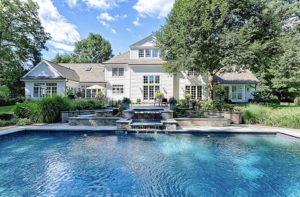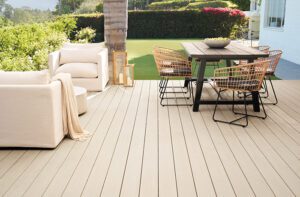The Phoenix
June 16, 2014
A New Hampshire lake house destroyed by fire rises from the ashes—better than ever.
Text by Nathaniel Reade Photography by Greg Premru
At 6:30 a.m. on a cloudy May morning in 2012, David Frost drove to his job site, same as any other day. He and his crew at White House Construction had been building a 3,900-square-foot house on New Hampshire’s Squam Lake for about a year, and it was nearly finished. When he drove down the driveway toward the water, however, the house was gone. Fire had blackened the huge pine trees, shattered the foot-thick concrete of the foundation, and turned a steel beam into what looked like a giant noodle.
“I’m an emotional guy,” Frost says. “I had tears in my eyes.”
It’s traumatic to lose any house, but this was more than a house; it was a work of art you could live in. Architect Chris Williams and project architect Rob Turpin had designed it around the footprint of a ramshackle old camp. At the owners’ request, they had used what’s called the Adirondack style—which, on the face of it, might seem more appropriate to New York than New Hampshire.
Not so, says Williams. “The Adirondack style was actually part of a movement back to nature in the late 1800s that occurred all across the northern part of the United States. The same thing was happening—building with logs and twigs—in northern Maine and Montana and Washington State, and at national-park facilities in places like Yosemite.”
Williams and the owners had chosen this style in part because of the way it blends into its surroundings. He and Frost’s crew, led by project supervisor Mark Pease, went to extraordinary lengths to make sure that neighbors across the lake would see water, not house—no easy task given that it sits just ten feet from the shore.
So whereas many builders clear a site of trees, Williams and Frost wove the housearound the existing pines, many of them twenty inches in diameter. “I always try to nestle the building into the existing landscape,” Williams says. “Why spend $200,000 on landscaping after cutting everything in sight, when you can work the house in among existing trees?”
Williams deliberately chose colors and materials that matched the bark and leaves of the woods. He used “live-edge” siding, where one edge of a board is left as it grew. Masons built out stone footings on the corners of the foundations, onto which Frost’s carpenters placed corner boards cut from whole logs of white cedar, the bark still on. The net effect was that, from the water, the house seemed to grow out of the forest.
After looking at lots of camps and buildings in the Adirondacks, Williams concluded that while they had “lots of nice moments in them,” he wanted to design a house that had “nice moments everywhere.” So the team didn’t just buy a door; they asked each other, ‘How can we make a door that’s truly special?’” They designed a distinctive detail for each room: a band of multicolored cherry and birch twigs in one room, lighting hidden beneath a dentil covered with white-birch bark in another. They crafted door pulls and towel bars from sticks.
They collaborated constantly. In the office, it was a finish carpenter’s suggestion to cover the frame of the cabinets with white birch bark and use the contrasting, buff-colored, interior bark for the cabinets’ panels.
“Getting these materials was a major undertaking,” says Williams. Several load-bearing hemlock posts inside had to be installed with the bark on, completely unmarred, requiring that they be cut in winter and wrapped in foam insulation during transport. Frost’s team cut those logs right at the ground to preserve the root flare, so when installed they looked as if they’d grown there.
When Williams’s designs called for peeled logs, Frost’s crew harvested them in early spring, when the bark was loose. They didn’t want the wood marred by tools, so they finished the process with a power-washer. “That way, the log has sinew to it,” Williams says, “like muscle on an arm.”
William and Susan Copeland, the owners, had spent years scouring auctions, flea markets, and antique shops for period lighting, furniture, and such details as Victorian-era doorknobs depicting deer heads. Vermont artist Dennis Sparling used metal for the custom light fixtures, but managed to replicate the feel of wood. He built chandeliers that look like tiers of grapevines, and fixtures of woodpeckers looking into a light-emitting hole.
While it’s never been proven, Williams thinks the house burned because of arson—volunteer firemen had seen a young man running from the fire. “It was a very traumatic experience for everyone,” Williams says.
The Copelands were devastated, but decided they needed to rebuild as a lesson to their children: when you fall off the horse, you get back on. “I was very happy,” Williams says. They got to make art all over again. Williams changed a few things, such as adding a cistern-fed sprinkler system in the house, and putting all the mechanical systems in a room so fireproof he describes it as a “vault.”
The fire had killed every tree within sixty feet of the house. Fortunately, the landscape contractor, who was also in the excavation business, found a lot close by that was about to be cleared for a shopping plaza, and he was able to move about thirty big trees. Williams, who handled the landscape design, added native plants such as ferns. “You feel very connected to the lake here,” he says. “You feel tied to the landscape.”
On a beautiful fall day of blue sky and red leaves a few months after he and his crew had finished construction, Frost returned to the house to replace a burned-out bulb. “The house was empty, the furniture was all in place, and everything was perfect,” he recalls. “I was able to see all the little details, the amazing fireplaces and the cedar post in the corner that we put there to look like it had been left over from the old part of the house. That’s when it finally hit me. I sat there and I thought, ‘This really is a work of art.’ It was such an honor to be able to work on it—twice.” •
Architect: Chris Williams, Christopher P. Williams Architects
Builder: David Frost, White House Construction
Share
![NEH-Logo_Black[1] NEH-Logo_Black[1]](https://www.nehomemag.com/wp-content/uploads/2022/08/NEH-Logo_Black1-300x162.jpg)























You must be logged in to post a comment.